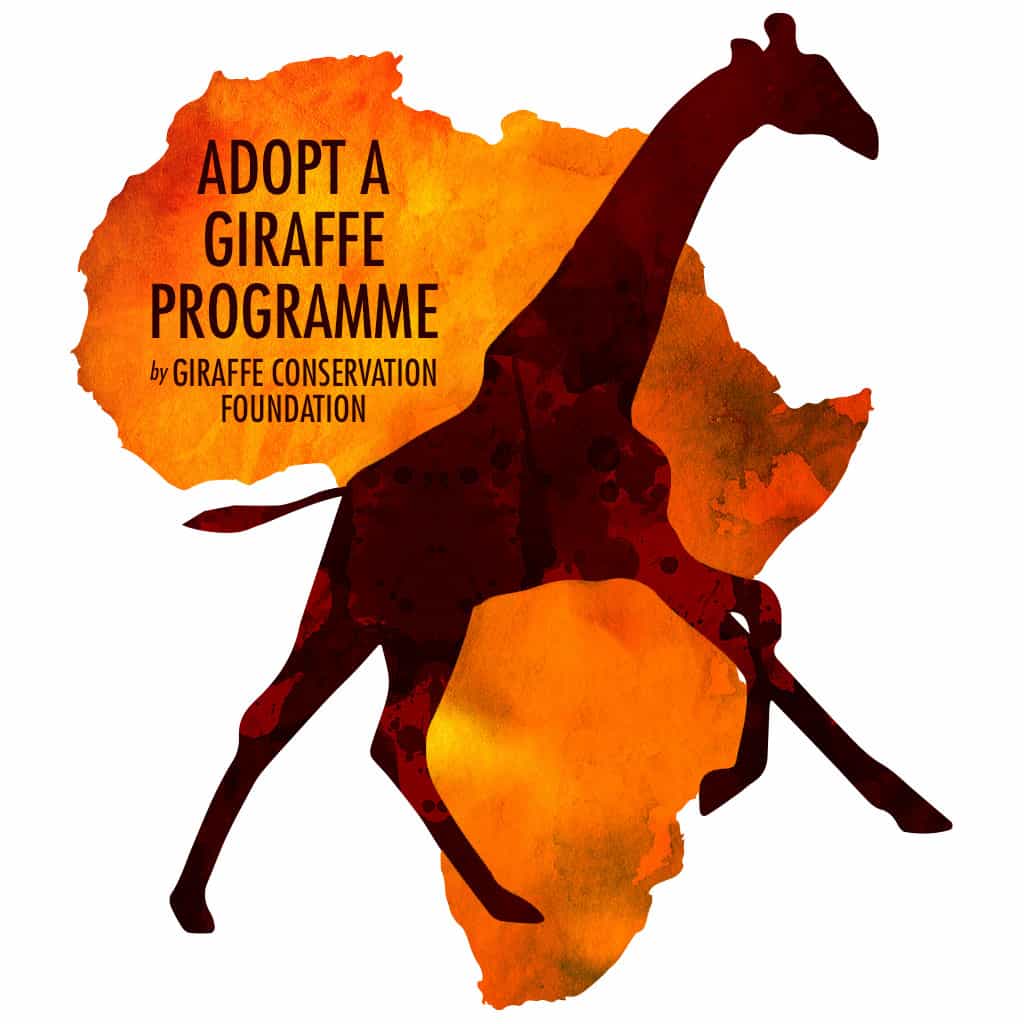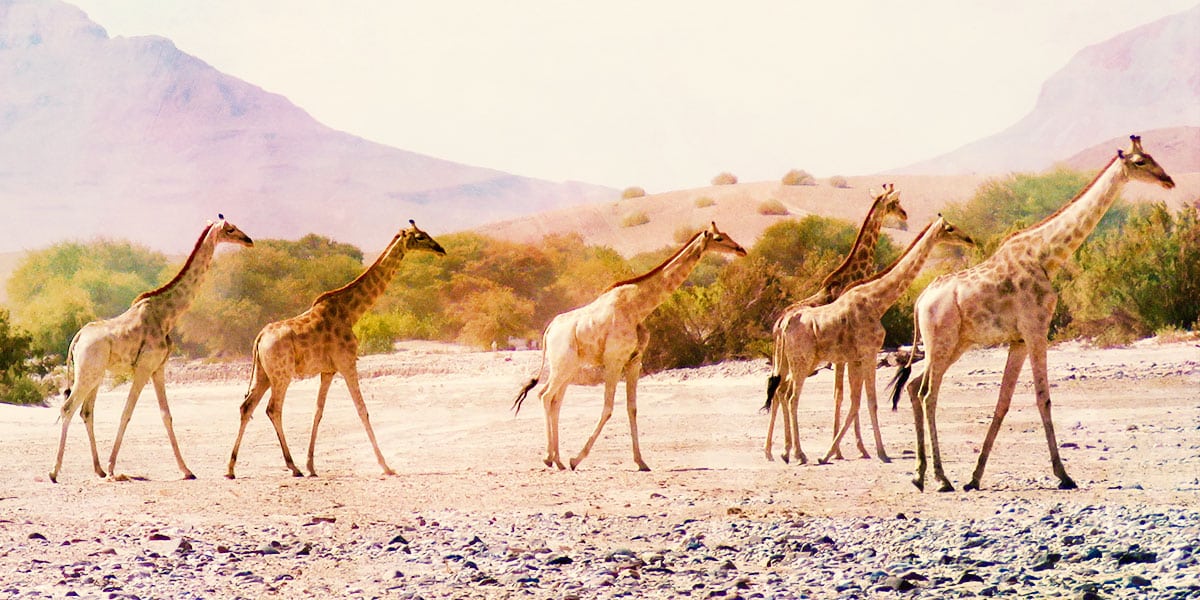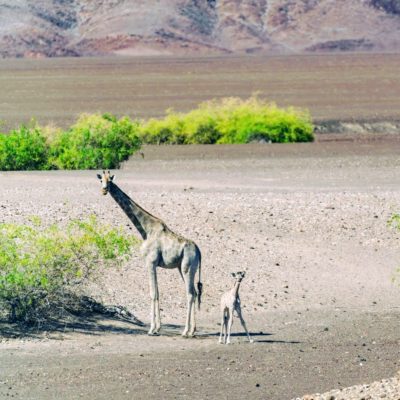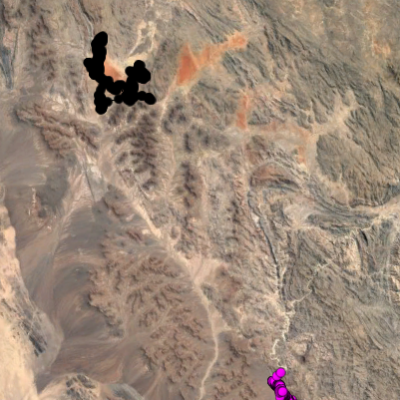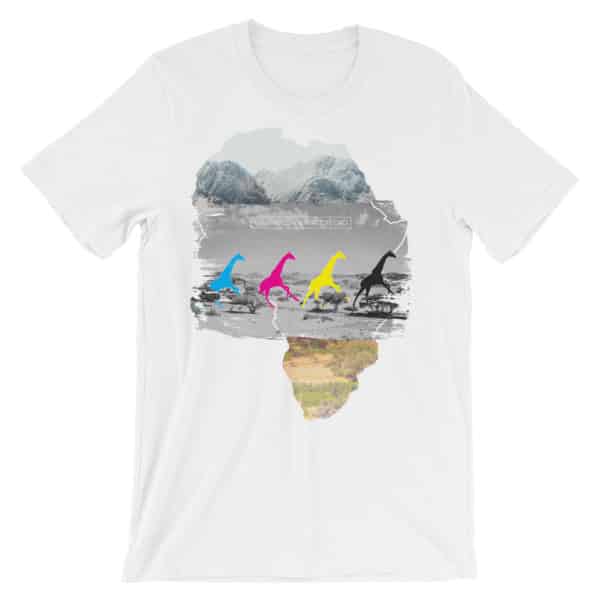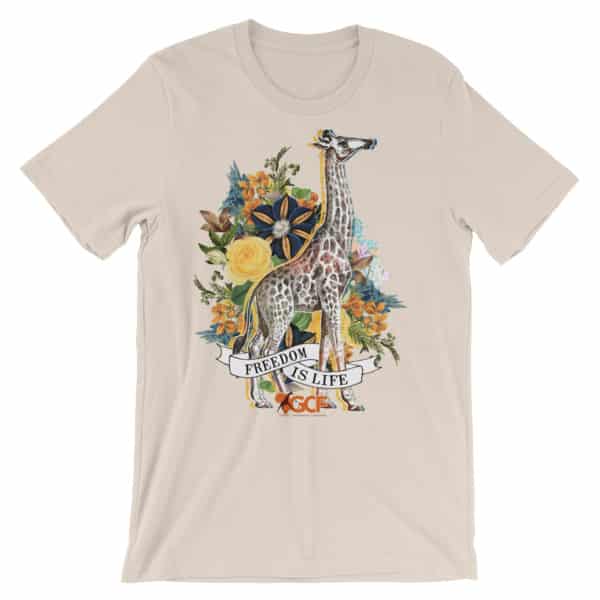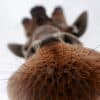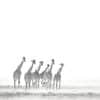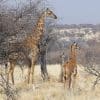Desert-Dwelling Giraffe of Northwestern Namibia
Desert-Dwelling Giraffe of Northwestern Namibia
Word from the Desert
O ur last Quarterly Update – January 2018 brought you news of the hot-dry season, where the giraffe rarely ventured out from the shade of large Ana (Faidherbia albida) or Acacia (Vachellia erioloba) trees during the hottest hours of the day. We waited on tenterhooks through February, watching as the grazing and browsing mammals grew thinner, and wondered if this year the rains would come.
What a relief when rain finally fell within the river catchments to the east and was channelled westward towards the Atlantic Ocean in March. What an amazing sight to see the Hoanib and Hoarusib Rivers in full flood, providing respite for dry and tired vegetation along their banks. Since the first flood the rains have kept coming, and what initially looked like a devastating year of drought has now turned into a year of late but heavy rains. Not only have all the rivers repeatedly been in flood, much of our conservation research area has been enlivened by rain showers. Seeds that have lain dormant in the sandy soil for many seasons have germinated giving the open plains a distinct green tinge of sprouting green shoots.
For our team the lower temperatures of the rainy season were a very welcome respite from the heat. However, the risk of flash floods in the rivers remains high and most of the study transects remained inaccessible during our last field trip as the area was waterlogged and impassable by vehicle. However, while we were forced to relocate our camping spots to higher ground, so too were the giraffe. Our GPS tracking data from tagged giraffe shows that a number of females who spend the majority of their time in the lower section of the Hoarusib River have headed south into the mountains in response to the flash floods. Here, due to the recent rainfall, they have been able to survive on the new growth of Commiphora and other stunted trees in the narrow ephemeral tributaries that run through the mountains. It is another reminder of how well adapted these giraffe are to the wide variety of challenges presented by their desert home.
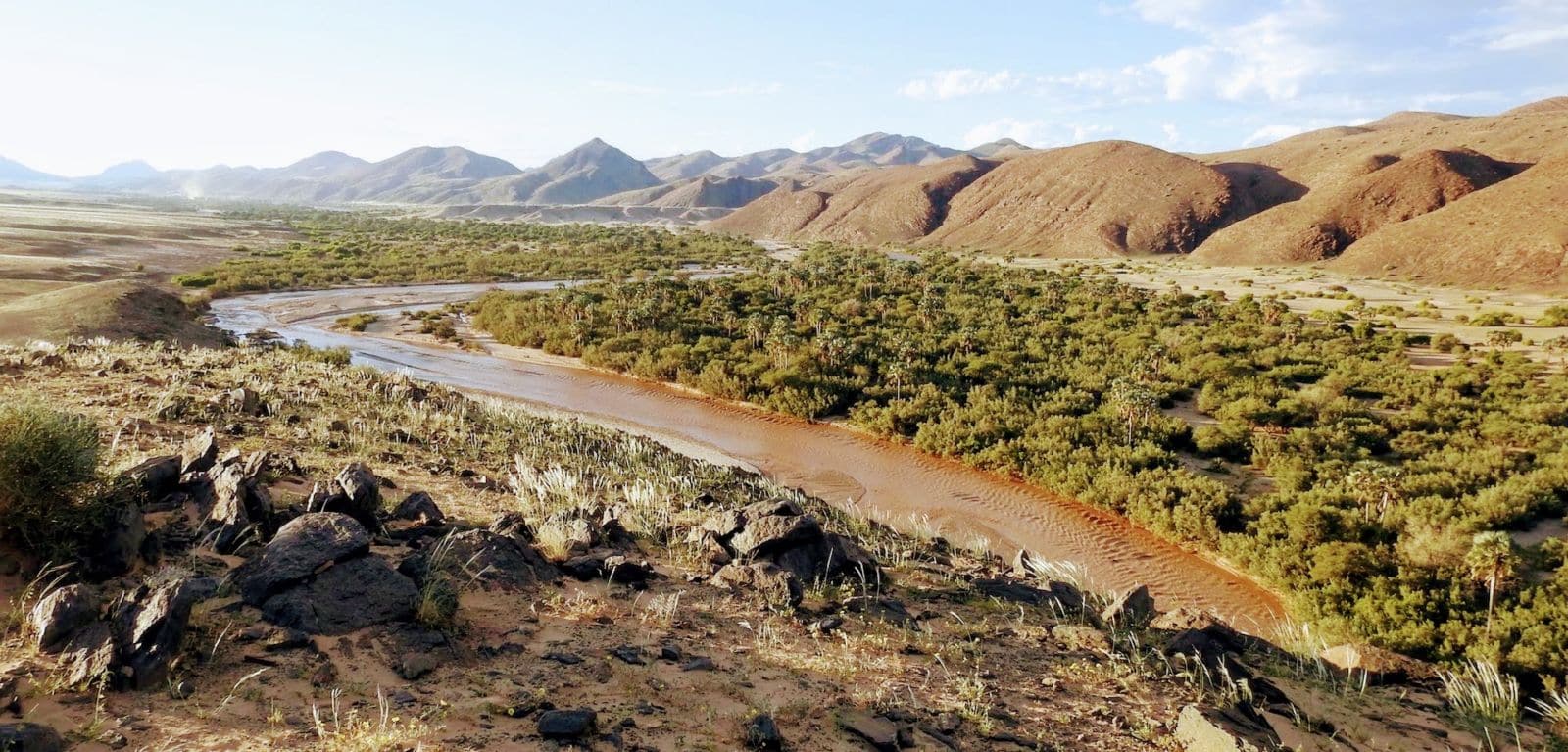
Amongst all the excitement of the rains we are happy to report that we have spotted some of our adopted giraffe amongst the many groups and individuals we have recorded since January.
Many of you will be thrilled to find out that Muffin has again been spotted in the Hoanib River!! As we mentioned in the January report, we think it quite likely that Muffin has been roaming far and wide these last months. From the giraffe that we have tagged with GPS satellite units we are learning that desert-dwelling giraffe move across much larger distances than previously assumed. For example, the small map above shows pink dots that represent the area where we originally tagged one of our female giraffe, while the black dots show her most recent location. What looks like a small distance on the map, is actually an amazing one hundred kilometres of high and challenging mountain terrain. A pretty impressive hike for a giraffe … If female giraffe are moving these distances, we believe that male giraffe, particularly young adults like Muffin, are likely moving even greater distances. This probably explains why we have not seen Muffin in some time and leaves us wondering where he spent these last months – if only giraffe could talk.

Why then did Muffin reappear in the Hoanib River in February? He probably only had one thing on his mind – breeding! When we came across Muffin he was travelling with a bachelor herd of four other males, all about the same age and size. They were closely following a group of females that are resident in the Hoanib River. Every now and again the males would size each other up and then engage in a bout of necking (hitting each other on the neck and backside with their ossicones, a typical male dominance behaviour). While none of these giraffe wrestling matches appeared very serious, there was no doubt that these young males were figuring out who would win the right to mate with the females! We can only assume that Muffin has roamed widely in search of the browse necessary to allow him to mature into a giraffe worthy of a mate and has now returned to try his luck with the Hoanib River females! What was particularly rewarding to see was how healthy and strong Muffin looked. He has matured into a confident bull and with the help of a long tongue (as you can see in his picture above) has now joined the ranks of those that can reach the highest branches!
While we were delighted to see Muffin after such a long absence, Kunene continued to remain elusive and Dobby too has avoided detection since January! We will keep our eyes peeled for these two special giraffe, however, we assume that they are most likely up to some clever giraffe business outside of our study area and we will catch up with them again only (like Muffin!) when they decide to reveal themselves!
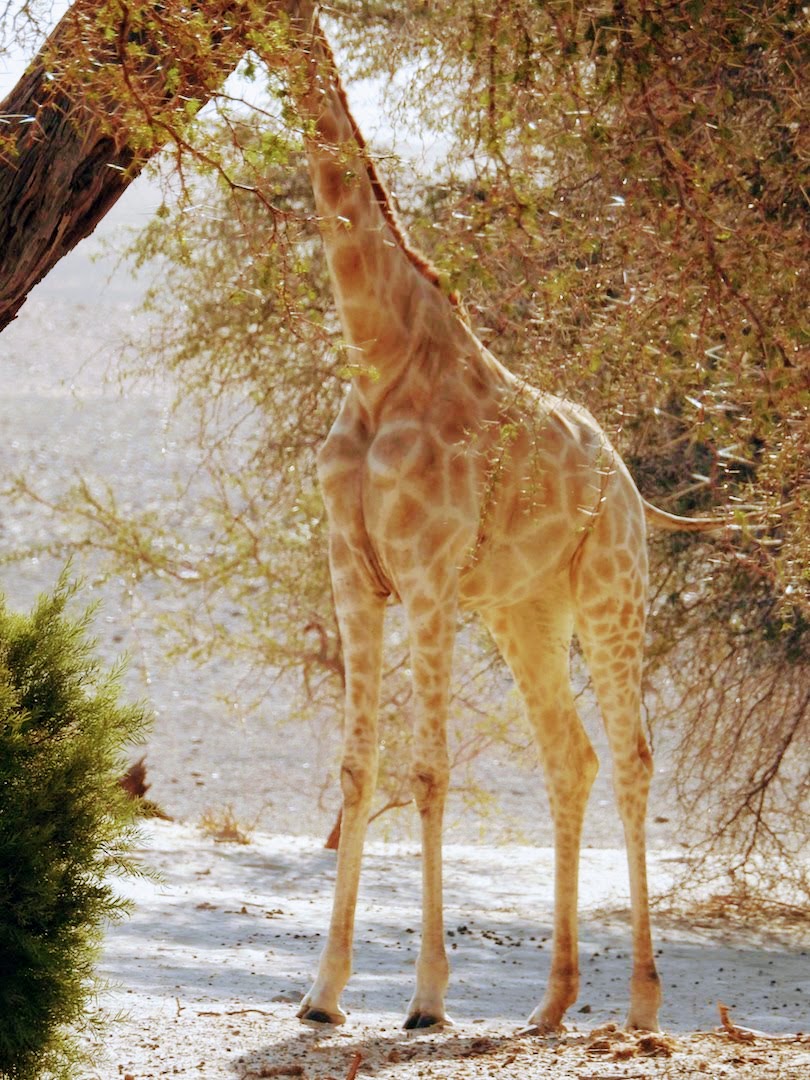
Monkey is very much up to her old tricks. While we often spot her in the distance spending her time in the Hoarusib River, she remains a master at evading photographs! This time we tried to approach her around some bushy undergrowth, only to be rewarded with a picture (see above) of her hiding her pretty face stubbornly behind a tree branch – luckily giraffe can be identified by their unique pelage (spot) pattern, so you can take our word for it that this is indeed Monkey. Monkey doesn’t seem to associate with the same group of giraffe as Kaoko, although both are usually to be found in the same middle section of the Hoarusib River. We don’t yet understand the reasons for this. Could it be that these younger females choose to spend their time with other females that they are genetically related to? Or, maybe such groups are comprised of giraffe that happened to be born in the same area? We can’t wait to start linking our observational data to the genetic biopsy data we have collected over the past years and to start answering some of these questions!
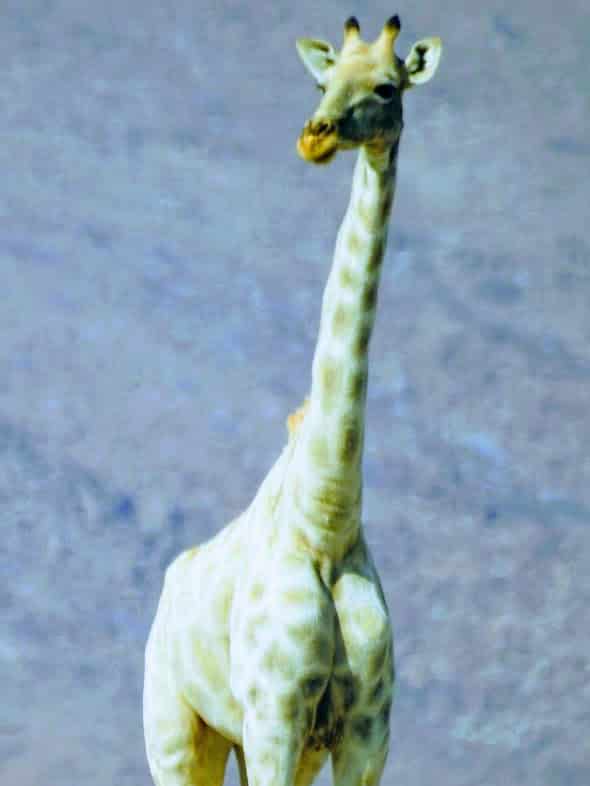
Kaoko on the other hand seems to have no desire to up sticks from the Hoarusib River. Despite the regular flash floods she has remained in her familiar stretch of riverbed, simply moving to the vegetated riverbanks when the water arrives. She is continuing to spend time with a mixed group of female and male giraffe and she grows into more of a beauty every day. It is interesting that some female giraffe, such as Kunene and a number of our GPS tagged giraffe, seem to choose to vacate the riverbeds during the wet season, while others, such as Kaoko, are content to stay in the rivers and accommodate the floods. Such individual differences in personality are interesting, and such variation may well hold part of the key as to how this species has adapted and survived to such extreme conditions in arid north-west Namibia.

In January we reported that Winky Wonk had managed to knock off his GPS tracking unit in an enthusiastic bout of necking. While this means that we can’t track his hourly movements anymore, he has been kind enough to spend some time in the company of one of our female tagged giraffe (see photo). As such we were able to keep track of his activities and can report that he is happy and healthy and spending time with the various groups of giraffe in the Hoarusib River. Winky Wonk is a mature bull and so he tends to move between herds rather than staying put with a particular group for too long. This strategy allows Winky Wonk to keep track of which females are coming into oestrus, and thus to have the best chance of siring as many offspring as possible. We are pretty sure that some of the tiny newborns in the Hoarusib must carry Winky Wonk’s genes forward into the next generation!
With browse once again likely to become abundant following the rains we can’t wait to see what the giraffe will get up to over the coming months. Never a dull day in the bush! Since February we have recorded five new births in our research area – new life arrived just in time for the flush that follows the rains. We look forward to keeping you posted, so look out in the adoption portal for the next Quarterly Update, which is due in late July/early August. In the meantime we are pleased to report that the desert-dwelling Angolan giraffe population in north-western Namibia is looking as happy and healthy as ever!
Thanks again for your support.
You continue to make giraffe conservation in north-western Namibia and throughout Africa a reality!
World Giraffe Day is coming soon!
Order your shirts now!
